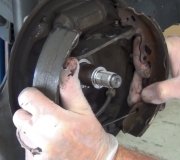Hyundai has a technical service bulliten about this, here is part of it, I will email the rest, it's 11 pages long.
Date: August, 1999 DESCRIPTION All 1999 and later Hyundai vehicles incorporate a new emission control system known as On- Board Refueling Vapor Recovery (ORVR). A general schematic of the system is provided in Fig. 1. Some owners may experience difficulty filling their vehicle with gasoline and a premature shut off condition as a result of the gas pump nozzles installed at their gas stations. The nozzles at these stations are in the process of being retrofitted or replaced by the nozzle manufacturers. In the meantime, owners should follow instructions posted near the gas pump, and/or try filling the vehicle at a different gas station. If the refueling difficulty continues, verify that the 1/2" vapor path from the fill vent valve on the gas tank to the air filter on the charcoal canister (see schematic below) is completely free and clear. To perform the procedure below, make sure the fuel tank is below 1/4 tank full. To quickly determine the general location of a possible vapor path restriction: Disconnect the hose connected to the canister side of the liquid-vapor separator. See Fig. 1. 1. Take the vehicle to a known "good" or major brand gas station. 2. If the vehicle readily accepts fuel, the restriction is located between the liquid-vapor separator and the air filter. A. If the vehicle does not easily accept fuel, the restriction is located between the liquid- vapor separator and the fuel tank. B. The following components are contained in the ORVR system: Vapor hoses "� Liquid-Vapor Separator(s) "� Fuel Fill Vent Valve "� Fuel Cut Valve (anti-spitback) "� Canister Close Valve "� Air Filter "� Charcoal Canister "� After the restriction has been isolated to either half of the system, inspect each component to make sure it is free and clear of any restrictions. See Fig. 2 and Fig. 3. Verify that no back pressure can be felt anywhere between the fill vent valve and the air filter at the canister. NOTE: 1999 Accents have two (2) liquid-vapor separators: one located on top of the fuel tank, the other located along side the filler neck. When checking the liquid-vapor separator, blow through one end of the pipe using lung pressure. See Fig. 4. No back pressure should be felt. Verify that the Fill Vent Valve is open by carefully removing the valve and confirming that the white plastic shut-off plunger moves freely inside its cage. See Fig. 5. If the fuel cut valve plunger is stuck closed, a hard-to-fill condition may result. Verify that the plunger moves up and down freely allowing fuel to enter the tank, but does not allow fuel to travel up the neck (under pressure). See Fig. 6. The plunger should be "up" (closed) in its free state. NOTE: When working with the Fill Vent Valve and associated plumbing, be sure to replace the hoses into the proper hose clips to prevent fuel from getting trapped/puddled in the vapor hose. Return fuel from the liquid-vapor separator must have a clear path to drain back to the tank. FOUR WAY VALVE See Fig. 7. Purpose: The Four Way Valve provides an additional vapor path to the canister during refueling NOTE: 1999 Sonatas have a Four Way Valve located between the liquid- vapor separator and fuel tank. Proper operation of the valve is as follows: Refer to Fig. 8. Air flows freely in either direction through the 1/2" ports. 1. Air flows freely in either direction through the 1/4" ports. 2. Air flows from 1/2" port to the 1/4" port when blowing into one of the 1/2" ports while plugging the other 1/2" port. 3. Air does not flow from 1/4" port to the 1/2" port when blowing into one of the 1/4" ports while plugging the other 1/4" port. 4.
Thursday, April 29th, 2010 AT 1:12 PM


